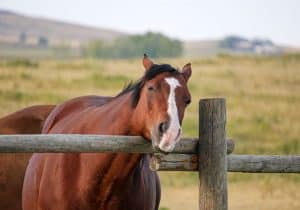Topline Dysfunction in Sport Horses
- Topics: Back and Spine, Horse Care, Lameness, Sports Medicine

“Back pain is a nebulous term that’s used quite liberally in the horse world,” said Tena Ursini, DVM, PhD, Dipl. ACVSMR, clinical instructor of equine sports medicine and rehabilitation at the University of Tennessee’s College of Veterinary Medicine, in Knoxville, during her presentation at the 2024 Veterinary Meeting and Expo, held Jan. 13-17 in Orlando, Florida.
3 Common Causes of Topline Problems in Horses
In her clinical experience as a board-certified sports medicine and rehabilitation veterinarian, Ursini has identified what she refers to as the “three-headed snake” when it comes to topline dysfunction in equine athletes:
- Weakness.
- Hypomobility/stiffness.
- Generalized pain.
“These three problems generally feed into one another, creating a vicious cycle of dysfunction through the horse’s topline,” Ursini explained. “As a result, we have a poorly performing horse who can’t do his job.”
Contributing Factors to Topline Dysfunction in Horses
A horse’s back might be sore for several reasons. Ursini encouraged fellow practitioners to consider both internal and external contributors, as well as coexisting conditions, when evaluating and addressing topline troubles. Internal factors can include conformation, specifically long backs and flat/negative plantar angles of the horse’s hind feet (the angle the bottom of each coffin bones makes with the ground), breed, which can affect conformation, age (both very young and very old horses tend to be weak under saddle), and hindlimb lameness, which is often secondary to back pain, or vice versa. External factors might include saddle fit, rider biomechanics and skill, discipline, and wear and tear over the horse’s career.
Comorbidities (conditions that occur simultaneously) can include:
- Osteoarthritis of the articular facets of the spine.
- Overlapping dorsal spinous processes (kissing spines).
- Interspinous ligament desmopathy. These primary tendon and ligament issues between vertebrae are relatively rare, said Ursini.
- Spinal nerve root compression.
How Equine Veterinarians Evaluate Topline Dysfunction
To identify topline dysfunction—regardless of the cause—Ursini typically begins her evaluations by assessing the horse’s muscle hypertonicity (inability to relax) and pain through palpation. “Some horses with back pain will tense up instead of yielding to pressure; it will feel like you’re palpating a brick wall,” she said. Ursini also performs a spinal mobility evaluation using manual exercises and baited (carrot) stretches, where she also assesses whole-body control, range of motion, and balance.
“You’ll be able to notice a restricted thoracolumbar spine that lacks flexion during the stretches,” Ursini explained, referring to the vertebrae over the ribs and loin. “The horse will ‘cheat’ and spin his body; he’ll be able to bend his neck around but won’t be able to reach further back than his girth because his thoracolumbar back is stuck.”
Treatment Options for Back Pain in Horses
Ursini said her treatment plan largely depends on the root cause of the problem. “Firstly, ask yourself if the horse’s primary problem is pain, stiffness/hypomobility, or weakness,” she said. For pain she recommended electroacupuncture, which releases endogenous opioids beneficial for pain relief, along with the Chinese herbal product marketed as Body Sore and regular stretching. “In cases of acute pain, joint injections, non-steroidal anti-inflammatory drugs (NSAIDs), muscle relaxants (i.e., methocarbamol), and shock wave therapy may or may not be needed—this is on a case-by-case basis.”
For horses with stiffness/hypomobility Ursini likes to use radiofrequency, chiropractic care, baited stretches, and groundwork exercises that include lots of flexion and bending such as leg yield in hand and serpentines, along with transitions and ground poles for core strengthening. For weakness she recommended gait transitions in a controlled and balanced manner, which build core and topline strength, as well as water treadmill exercise to build strength and muscle mass.
Take-Home Message
Ursini has found through her clinical experience that pain, weakness, and stiffness through a horse’s topline tend to create a vicious cycle of dysfunction that can only be resolved with veterinary intervention. Once the problem is resolved, maintaining a fit, strong, and supple horse long-term requires commitment and diligence on the owner’s part.

Written by:
Lucile Vigouroux
Related Articles
Stay on top of the most recent Horse Health news with















